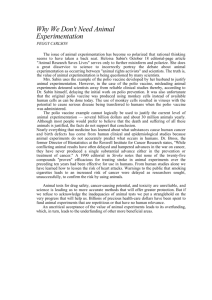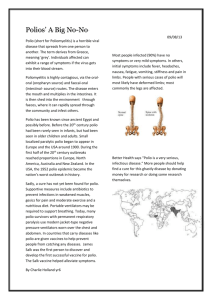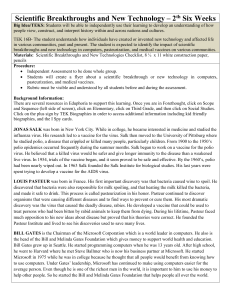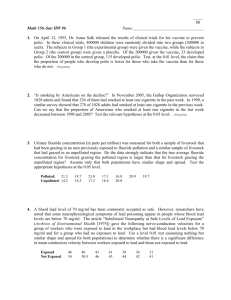Summit County scientist joins effort to end polio once and for all by
advertisement
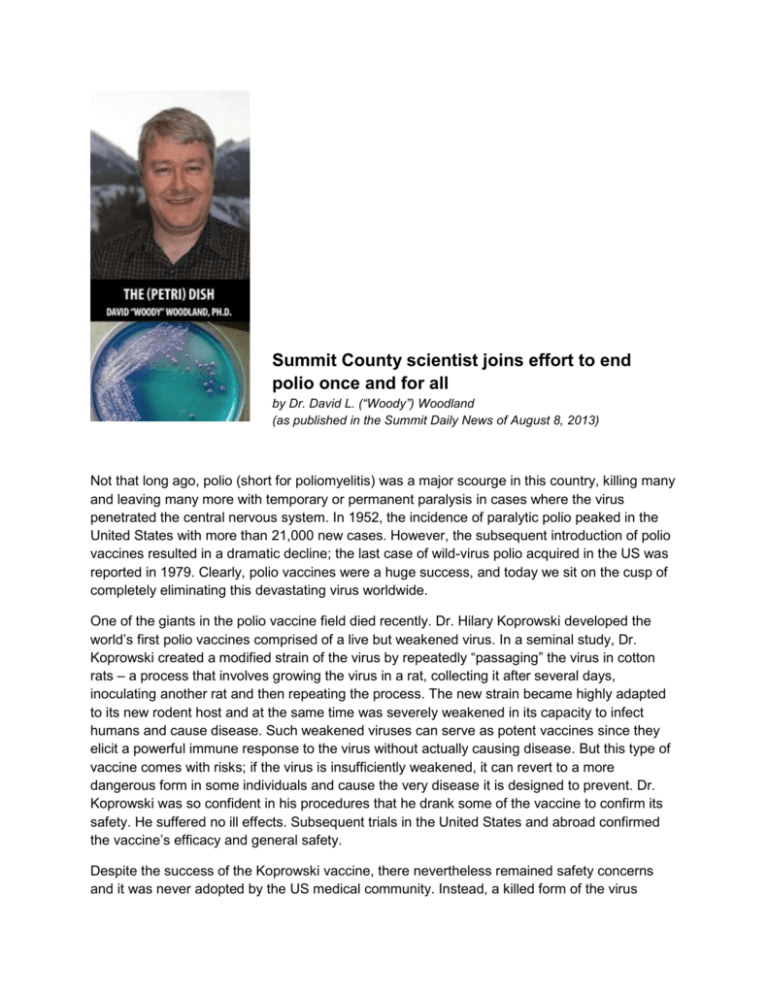
Summit County scientist joins effort to end polio once and for all by Dr. David L. (“Woody”) Woodland (as published in the Summit Daily News of August 8, 2013) Not that long ago, polio (short for poliomyelitis) was a major scourge in this country, killing many and leaving many more with temporary or permanent paralysis in cases where the virus penetrated the central nervous system. In 1952, the incidence of paralytic polio peaked in the United States with more than 21,000 new cases. However, the subsequent introduction of polio vaccines resulted in a dramatic decline; the last case of wild-virus polio acquired in the US was reported in 1979. Clearly, polio vaccines were a huge success, and today we sit on the cusp of completely eliminating this devastating virus worldwide. One of the giants in the polio vaccine field died recently. Dr. Hilary Koprowski developed the world’s first polio vaccines comprised of a live but weakened virus. In a seminal study, Dr. Koprowski created a modified strain of the virus by repeatedly “passaging” the virus in cotton rats – a process that involves growing the virus in a rat, collecting it after several days, inoculating another rat and then repeating the process. The new strain became highly adapted to its new rodent host and at the same time was severely weakened in its capacity to infect humans and cause disease. Such weakened viruses can serve as potent vaccines since they elicit a powerful immune response to the virus without actually causing disease. But this type of vaccine comes with risks; if the virus is insufficiently weakened, it can revert to a more dangerous form in some individuals and cause the very disease it is designed to prevent. Dr. Koprowski was so confident in his procedures that he drank some of the vaccine to confirm its safety. He suffered no ill effects. Subsequent trials in the United States and abroad confirmed the vaccine’s efficacy and general safety. Despite the success of the Koprowski vaccine, there nevertheless remained safety concerns and it was never adopted by the US medical community. Instead, a killed form of the virus generated by Dr. Jonas Salk was introduced as an injectable vaccine in the mid-1950s. This was subsequently followed by a live but weakened virus developed by Albert Sabin in the late 1950s.The Sabin vaccine was delivered orally and was very similar to the vaccine developed by Dr. Koprowski, but even more severely weakened. Although Dr. Koprowski’s vaccine was never adopted here, there is no question that he paved the way to the highly effective Sabin polio vaccine by demonstrating the feasibility of this vaccine approach. The success of the polio vaccine campaign in the US was due largely to the efforts of President Franklin D. Roosevelt, who contracted polio as an adult and lost the use of his legs. He established the National Foundation for Infantile Paralysis, later renamed the March of Dimes Foundation, to finance the Salk and Sabin vaccines. Today, the two vaccines have eradicated polio from most countries in the world. Only Afghanistan, Pakistan and Nigeria still harbor transmission of the wild virus, and the number of new global cases fell to a record low of 223 in 2012, although there was a recently small polio outbreak in the horn of Africa. These impressive results are due to a wonderful collaborative effort of the United Nations, governments, foundations, businesses and Rotary International, which adopted this as a global cause (Rotary has contributed hundreds of millions of dollars for polio eradication). The successful battle against polio is an extraordinary example of what can be achieved through a cooperative global effort. Recently, I joined 450 scientists from 80 countries to offer support for a final push against polio. The Global Polio Eradication Initiative involves a global public-private partnership that has vowed to eliminate polio in six years at a cost of $5.5 billion. This will be achieved through enhanced surveillance and vaccination strategies in affected countries. While the financial cost may seem high to some, this is cheap compared to the costs of dealing with a polio resurgence. It has been estimated that polio eradication efforts so far have saved more than 10 million people from paralysis and saved over $40 billion in medical costs in some of the world’s poorest countries. Significant challenges remain in the countries where polio is still being transmitted. These include the lack of effective public health systems, distrust of vaccination (including the murder of volunteers administering the vaccine) and nomadic populations (which can serve as a viral reservoir). But as stated by the Global Polio Eradication Initiative, “ending one of the world’s most enduring diseases will create a ‘global public good,’ in that the benefits of a polio-free world will extend to all children everywhere, in perpetuity, protecting them forever from this debilitating, preventable disease.“ David L. “Woody” Woodland, Ph.D. is the Chief Scientific Officer of Silverthorne-based Keystone Symposia on Molecular and Cellular Biology, a nonprofit dedicated to accelerating life science discovery by convening internationally renowned research conferences in Summit County and worldwide. Woody can be reached at 970-262-1230 ext. 131 or woody@keystonesymposia.org. To view more (Petri) Dish articles, please visit “News” on the Keystone Symposia website.

